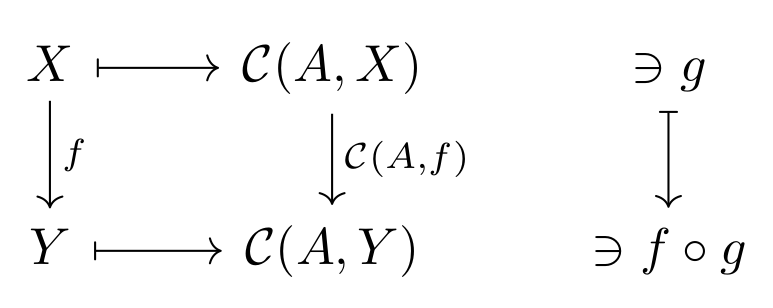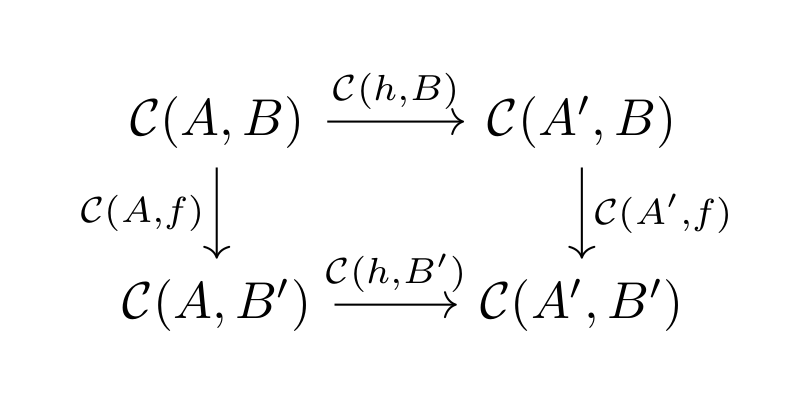For the following let \( \mathcal{C} \) be a locally small category.
Given \( \mathcal{C} \), each object \( A \) determines a functor $$ \mathcal{C}(A,-) : \mathcal{C} \rightarrow Set $$ This functor takes each \( \mathcal{C} \)-object \( X \) to the set \( \mathcal{C}(A,X) \), that is the set of arrows from \( A \) to \( X \). Furthermore the functor takes each \( \mathcal{C} \)-arrow \( f : X \rightarrow Y \) to the function $$ \mathcal{C}(A,f) : \mathcal{C}(A,X) \rightarrow \mathcal{C}(A,Y) $$ given as $$ \mathcal{C}(A,f)(g : A \rightarrow X) = f \circ g $$ where the right side composition, \( f \circ g \), is in \( \mathcal{C} \). \( \mathcal{C}(A,-) \) is called a hom-functor. This is sketched in Figure 1.

We can prove that the above is a functor. Fix the object \( A \). Let objects \( X,Y \). All in \( \mathcal{C} \). Let \( F \) be shorthand for \( \mathcal{C}(A,-) \), that is \( F(X) = \mathcal{C}(A,X) \) and for \( f : X \rightarrow Y \) in \( \mathcal{C} \) we have that \( F(f) = \mathcal{C}(A,X) \rightarrow \mathcal{C}(A,Y) \). Now let \( f : X \rightarrow Y \) and \( g : Y \rightarrow Z \) in \( \mathcal{C} \). And we get $$ F(g \circ f) = \mathcal{C}(A,X) \rightarrow \mathcal{C}(A,Z) $$ and $$ F(g) F(f) = (\mathcal{C}(A,Y) \rightarrow \mathcal{C}(A,Z)) (\mathcal{C}(A,X) \rightarrow \mathcal{C}(A,Y)) $$ and hence $$ F(g) F(f) = \mathcal{C}(A,X) \rightarrow \mathcal{C}(A,Z) = F(g \circ f) $$ Furthermore we have that $$ F(id_X) = \mathcal{C}(A,X) \rightarrow \mathcal{C}(A,X) = id_{F(X)} $$
The contravariant hom-functor is defined as $$ \mathcal{C}(-,B) : \mathcal{C}^{op} \rightarrow Set $$ that takes each object \( X \) to the set \( \mathcal{C}(X,B) \). Each arrow \( h : X \rightarrow Y \) is taken to the function $$ \mathcal{C}(h,B) : \mathcal{C}(X,B) \rightarrow \mathcal{C}(Y,B) $$ given as $$ \mathcal{C}(h,B)(g : X \rightarrow B) = g \circ h $$ As shown in Figure 2. Note that since \( h \in \mathcal{C}^{op} \), we have the reverse version as \( h : Y \rightarrow X \in \mathcal{C} \). Hence we have that \( g \circ h \in \mathcal{C}(Y,B) \).

The two above are related in a natural manner. That is for every \( \mathcal{C} \)-arrows \( f : B \rightarrow B' \) and \( h : A' \rightarrow A \) the following diagram commutes

The bivariant hom-functor is for objects defined as $$ \mathcal{C}(-,-) : \mathcal{C}^{op} \times \mathcal{C} \rightarrow Set $$ This is just a composite of the two above functors.